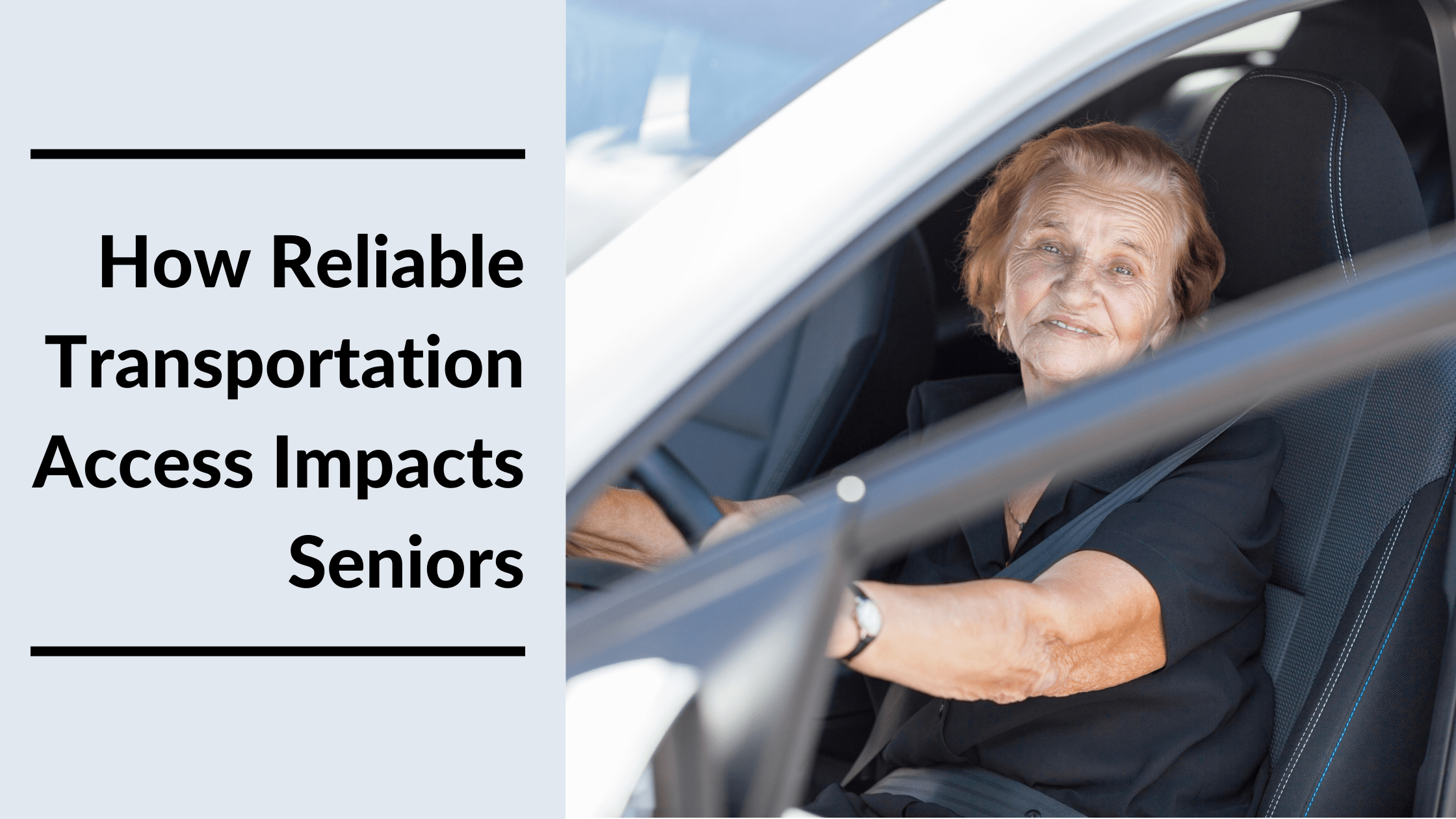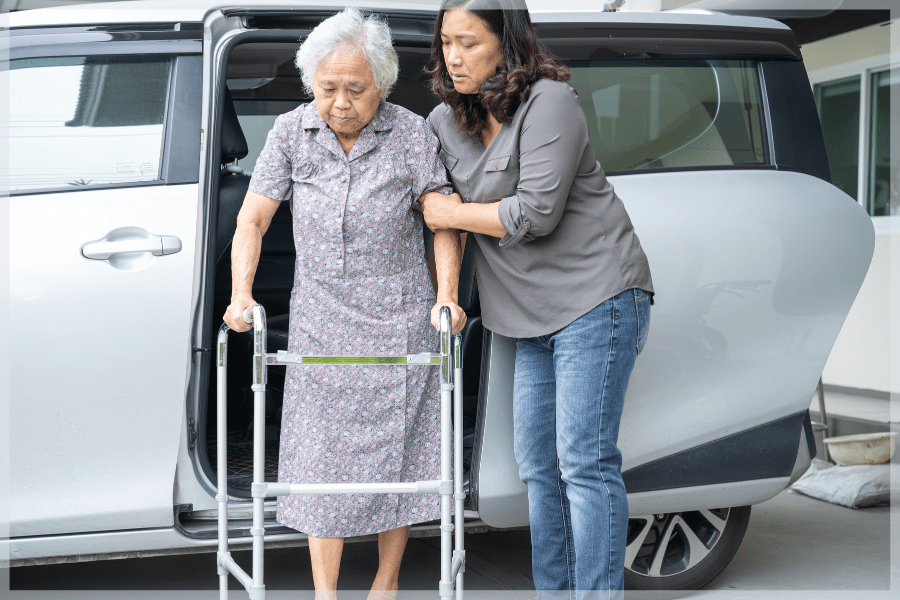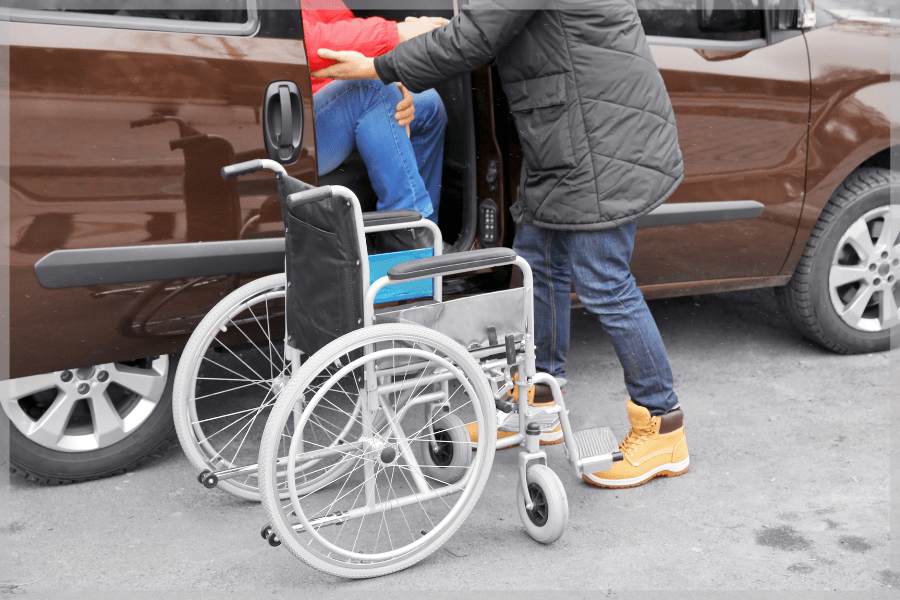
Reliable transportation is essential for quality of life at every age. But for seniors, a lack of transportation options can create significant obstacles to aging in place and general wellbeing. In this article, we explore how the absence of reliable transportation influences other social determinants of health and directly impacts vulnerable communities.
Reliable Transportation As A Social Determinant Of Health
Access to reliable public or private transportation dramatically impacts our overall quality of life. Yet, we often forget how much easier life is when you can hop in the car or the bus to run errands and other activities.
Unfortunately, many people don’t have this convenience. According to data from the 2020 US Census Bureau American Community Survey, 8.45% of American households lack access to a vehicle. The American Public Transportation Association (APTA) also found that 45% of Americans have no public transit options.
Access to private or public transport regularly affects both urban and rural areas. According to the American Hospital Association (AHA), the most common barriers to reliable transportation include the following:
- Cost
- Lack of vehicle access
- Long distances or travel times
- Inadequate public infrastructure
- Unfavorable policies concerning travel
For these people, lack of accessible transportation often means missed health appointments, social outings, and more. For seniors, in particular, the absence of reliable transportation is a social determinant of health that could result in poorer health and higher isolation rates.
Social determinants of health (SDOH) are intangible and tangible factors that significantly influence people’s health, wellbeing, and quality of life. Examples of tangible SDOH include access to:
- Healthy food
- Affordable housing
- Clean air and water
- Safe neighborhoods
- Reliable transportation
- Educational and career opportunities
Examples of intangible SDOH include:
- Ageism
- Racism
- Violence
- Discrimination
A 2019 issue brief by the Robert Johnson Wood Foundation found that these factors are so important that they affect nearly 80% of health outcomes.
How Reliable Transportation Access Affects Seniors
As a vital part of the built environment, reliable transportation can significantly affect public health and health equality. Social determinants of health often intertwine, leading to or worsening other health disparities and inequalities. Someone without access to reliable transportation may struggle to:
- Obtain better employment and education opportunities
- Attend social events or recreational outings, leading to loneliness and isolation
- Reach everyday necessities such as grocery stores, pharmacies, and nutritious food.
A 2016 study suggested that an individual’s overall health was affected:
- 10% to environmental factors (i.e., air and water quality)
- 20% by clinical care
- 30% to diet and exercise
- 40% to socioeconomic factors (i.e., education, employment, income)

Transportation access plays a part in each of these areas. When people can easily travel via public or private vehicles, their risk of loneliness and isolation significantly drops. It also makes it easier to attend routine health appointments, raising the rate of preventative screenings and tests. Ultimately, these factors improve health outcomes and overall quality of life.
A 2019 McKinsey & Co. survey found that people prioritize reliable transportation so much that they consider it as important to their health as medical care. There are many reasons why, such as those listed above. However, a lack of reliable transportation can also affect you mentally and emotionally. For example:
- Someone who must give up the keys will likely feel a significant loss of autonomy or independence.
- Someone who lives in a rural area may feel isolated or lonely without the ability to engage with others regularly.
- Someone living in a mid-sized town with poor or no transportation options may struggle to shop at cheaper stores, creating a more significant financial burden.
There are many other examples of how transportation affects peoples’ wellbeing and quality of life. As demand for accessible transit rises, so will transportation assistance for seniors and those with disabilities.
How Reliable Transportation Impacts Caregivers
90% of older adults want to age in their homes and communities. However, doing so requires access to everyday services, including medical care. Without accessible, dependable, and affordable options, more seniors will have to consider moving to a long-term care facility. Furthermore, seniors who live far from family or require regular rides may require more conventional services to meet their needs.
Family caregivers play a significant role in filling this need. According to the National Alliance for Caregiving and AARP, 80% of family caregivers provide or coordinate rides for their loved ones. A 2018 National Aging and Disability Transportation Center (NADTC) survey also found that 20% of caregivers spend five hours per week providing or organizing rides, with 19% spending ten or more hours.
Although most caregivers are willing to assist their loved ones with this critical need, transportation assistance is a time-consuming responsibility that can create more stress for caregivers by impacting their jobs and incomes.
How Reliable Transportation Improves Health Equity
According to the Centers for Disease Control and Prevention (CDC), “health equity is achieved when every person has the opportunity to ‘attain his or her full health potential’ and no one is ‘disadvantaged from achieving this potential because of social position or other socially determined circumstances.'”
A 2019 US Census Bureau report found that 5% of the US workforce relies on public transport to commute to work. Previously, a 2016 study concluded that poor public transportation access significantly affects older adults and people with disabilities.
Furthermore, this problem worsens existing racial and economic injustices by hindering mobility to vehicle ownership. In most cases, this problem predominantly impacts women, young adults, Black commuters, and low-income individuals.
A growing body of research finds that cess to public transportation can positively influence health and health equity in various ways, for example:
- Public transport reduces the number of vehicles on the road, reducing the risk of crashes.
- Fewer vehicles also mean fewer emissions and improved air quality.
- Less air pollution means lower rates of cancer and severe health conditions.
As public awareness about inclusion and social determinants of health spreads, so will calls for cross-sector collaboration among healthcare professionals, transportation and mobility organizations, public health groups, and others.
How Reliable Transportation Affects Health Outcomes

Reliable transportation directly impacts health outcomes because it increases access to medical services. Studies show that limited transportation options increase the rate of missed or postponed health appointments, lower health outcomes, and higher costs.
Furthermore, seniors, people with disabilities, or those without a vehicle who have limited access to public transportation can experience higher instances of social isolation. This can increase the risk of numerous health problems, from depression to cardiac arrest to early death.
On the other hand, reliable transportation encourages people to seek healthier foods, health services, jobs, leisure activities, and other necessary activities that impact the quality of life. In addition, communities with reliable transportation have higher levels of physical activity due to walking to transit stops.
Physical activity is linked to lower rates of obesity, diabetes, heart disease, and more. These conditions are common across the country. However, they primarily impact low-income and vulnerable communities. In addition, lack of access to reliable transportation compounds these conditions by making it harder for these communities to seek medical care.
For example, a 2005 analysis by the Transportation Research Board found that 3.6 million Americans miss or postpone medical care every year due to a lack of transportation. Non-emergency medical transportation (NEMT) and non-emergency transportation (NET) services make up less than 1% of healthcare costs. Yet many health plans do not cover these services. Reliable transportation access to healthcare significantly increases health outcomes and lowers health costs.
How Reliable Transportation Addresses Other Social Determinants Of Health
Historically, policy, planning, and infrastructure investments have prioritized roads and private vehicle ownership over public transportation. Unfortunately, this has created numerous health risks and segregated populations throughout the country.
New or augmented public transit options increase access to and use public transport. In turn, this leads to better health outcomes by reducing air pollution, raising physical activity levels, lowering the number of crashes, and enhancing mental health.
Furthermore, better access to republic transportation could ease health inequalities and encourage healthier lifestyles. Ease of travel improves access to nutritious food options, health care, critical services, and employment opportunities for communities that lack access to these essential everyday resources.
Economic Stability And Employment
Economic security and employment are two factors that impact peoples’ overall financial circumstances: the ability to afford housing, food, and self-worth. For example, reliable transportation helps the unemployed access training, job fairs, and other local assistance that help with job searches. Moreover, it ensures that people who have a job have a reliable way to commute to and from work.
Neighborhood And Physical Environment
According to a 2020 US Census Bureau brief, 37.2 million Americans live in poverty. Economic hardship hinders the ability to afford safe housing, including the physical conditions of the home. However, reliable transportation to parks, events, and other recreational activities lower how much time people spend in dangerous home situations. Furthermore, reliable transportation gives these people better access to materials and equipment for home modifications to help housing pass safety inspections.
Food Quality And Security
Food insecurity raises the risk of chronic disease and developmental problems. In addition, food-insecure individuals report higher emergency room visits and hospital readmission rates. Reliable transportation allows people to leave food deserts and access grocery stores and food pantries.
Community And Social Connection
Limited social connections contribute to a lack of purpose, engagement, and belonging, leading to social isolation. In seniors, social isolation can increase mortality due to dementia, stroke, heart disease, and more. Reliable transportation helps overcome these problems by allowing people to regularly attend social events, entertainment, adult day facilities, senior centers, and more.
Need Reliable Transportation?
MeetCaregivers Can Help
For many seniors, the absence of reliable transportation significantly contributes to other unmet needs. Many seniors lack transportation due to cost, health conditions, or other reasons. Many more live in areas with poor public transit. Many cannot afford taxis or rideshares for everyday activities, and many health insurance plans don’t cover transportation assistance.
MeetCaregivers is partnering with Medicare Advantage plans to deliver home care as a supplemental benefit to more people across the US. By partnering with health plans, we aim to improve their members’ quality of life and health outcomes and lower healthcare costs.
We understand the critical role of reliable transportation in seniors’ overall quality of life. Our licensed and insured caregivers can provide rides to errands, social activities, religious services, and more.
To get started, Find A Caregiver today, or call 1 (888) 541-1136 to talk one-on-one with a care manager who can answer any questions you have.
Visit our Blog to find more resources for seniors, families, and caregivers.
- AHA. (2017, November 15). Social Determinants of Health Series: Transportation and the Role of Hospitals. Social Determinants of Health Series: Transportation and the Role of Hospitals: AHA. Retrieved August 31, 2022, from https://www.aha.org/ahahret-guides/2017-11-15-social-determinants-health-series-transportation-and-role-hospitals
- American Hospital Association. (n.d.). Social Determinants of Health Series: Transportation. Social Determinants of Health Series: Transportation – HPOE.org. Retrieved August 29, 2022, from http://www.hpoe.org/resources/ahahret-guides/3078
- CDC. (2022, August 16). Activity-Friendly Routes to Everyday Destinations. Activity-Friendly Routes to Everyday Destinations | CDC. Retrieved August 29, 2022, from https://tinyurl.com/44j7299f
- Healthy People 2030, U.S. Department of Health and Human Services, Office of Disease Prevention and Health Promotion. Retrieved [date graphic was accessed], from https://health.gov/healthypeople/objectives-and-data/social-determinants-health
- Heaps, W., Abramsohn, E., & Silken, E. (2021, July 29). Public Transportation In The US: A Driver Of Health And Equity. Retrieved August 29, 2022, from https://www.healthaffairs.org/do/10.1377/hpb20210630.810356/full/
- MTM. (2022, August 19). Social Determinants of Health (SDOH). Social Determinants of Health (SDOH) – MTM, Inc. Retrieved August 29, 2022, from https://www.mtm-inc.net/healthcare/social-determinants-of-health/
- NADTC. (n.d.). Older Adults & Transportation. Older Adults & Transportation | NADTC. Retrieved September 2, 2022, from https://www.nadtc.org/about/transportation-aging-disability/unique-issues-related-to-older-adults-and-transportation/
- National Aging and Disability Transportation Center, KRC Research. (2019, February 13). NADTC National Poll: Transportation Needs and Assessment. NADTC National Poll: Transportation Needs and Assessment | NADTC. Retrieved September 2, 2022, from https://www.nadtc.org/wp-content/uploads/KRC-nadtc-Survey-Report-120718-FINAL_for-web508.pdf
- NCMM. (2022, May 2). Transportation + Social Determinants of Health. Transportation and Social Determinants of Health Destinations. Retrieved August 29, 2022, from https://nationalcenterformobilitymanagement.org/transportation-and-social-determinants-of-health-destinations/
- Wright, A. (2021, March 17). SDOH and the Impact of Transportation. SDOH and the Impact of Transportation – MTM, Inc. Retrieved August 29, 2022, from https://www.mtm-inc.net/sdoh-and-the-impact-of-transportation/
